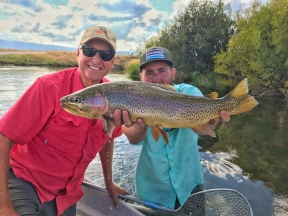
If you’re like me, you’re a lot more interested in what to expect in 2018 than what happened last year. However a basic understanding of the events of 2017 that shaped the fishing can be valuable. Our best indicator is where our guiding efforts were concentrated. It can give an interesting perspective with guide trip comparisons with 2017 and 2016.
Henry's Fork
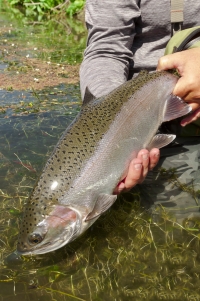
One word says it all. Awesome! To be honest it would have been unrealistic to expect better than average fishing at the start of 2017. We started the year with a near empty reservoir at Island Park. The flow at the dam throughout the prior winter was just above 130 cfs. We were coming off one of the driest years on record in the Henry’s Fork drainage. A year ago at this time our snowpack wasn’t all that great.
We started off with a pretty good snowpack but by the middle of March things really started to look grim. Check out Rob Van Kirk’s blog submitted on April 3 on the Henry’s Fork Foundation website. After that it started to rain and snow and basically it didn’t stop. By the middle of June our snowpack was well above normal in the entire watershed. On top of that trout population estimate conducted by the IDFG in the Box Canyon was above average.
Cool wet spring weather was very helpful for our early season BWO, March Brown and caddisfly hatches. Target hatches of salmonflies, PMDs, Green Drakes and Flavs were right on schedule. Our high stream flows also brought anticipation of an epic Gray Drake hatch. For reasons completely unknown this didn’t happen. While our Brown Drake hatch on the Ranch produced some great evening dry fly fishing, it wasn’t exceptional. Yet the season on the Ranch provided good aquatic insect activity throughout the summer and well into autumn. Hopper fishing was also productive later in the summer. Personally I’ve never seen the numbers of truly large trout for many years even though I didn’t land many of them.
The lower stretches of the Henry’s Fork above and below Ashton have always provided solid fishing throughout the year but this year was even better than normal. Aquatic insect activity held strong through the middle of July. After that we continued to catch large brown and rainbows on hoppers and streamers. Aquatic insect activity picked up again in September and intensified in October.
The best indicator of what the fishing on the Henry’s Fork was like was where our guides went. With options like the Teton, Madison, South Fork, Yellowstone Park and more, our guides try to go where the fishing is best. Overall we ran only about 1% more trips than last year. Yet our trips on the Henry’s Fork were up just under 23% above 2016.
Madison River
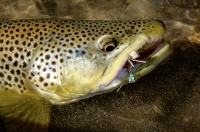
We started out fishing the Madison in February. The section from Quake Lake to McAtee is open through the end of February. Fishing was excellent in this stretch of water with nymphs. When the weather was right there was also great dry fly fishing with midges.
Like other rivers in our area the Madison carried high runoff in May and June but the end of the month the salmonflies started and worked their way up the river. The hatch was a bit sporadic with large concentrations of naturals in one stretch and minimal activity in others. As usual the salmonflies brought out lots of anglers and the river was very busy, especially in the float section below Lyons Bridge.
There were also some very good caddisflies, mayflies and small stoneflies emerging throughout the month of July. Float fishing continued to be productive but some of the better fishing was in the wade section. Evening fishing was very productive.
Fishing slowed during the heat of the summer as a result of warmer water temperatures. Work on the Hebgen Dam has resulted in poor fishing during the heat of the summer due to the outflow over the top of the dam. This should be alleviated moving forward as it is our understanding that the work has been completed so water can be drawn from the bottom of the lake which will result in cooler water temperatures.
Fishing picked up again in September as it usually does. In checking our trip reports Henry’s Fork Anglers’ guides ran 39% more trips on the Madison in 2017 than the prior year.
South Fork
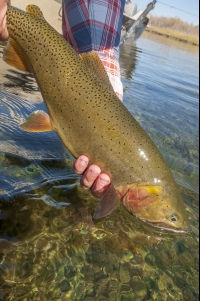
By late April we knew that the South Fork would be very high. The snowpack was almost 200% of normal. In fact rumors were flying that the river would flood like it did in 2011. It wasn’t as bad as 2011 but it was bad. By mid-June the flow from Palisades was over 24,000 cfs. It stayed over 20,000 cfs until almost the end of June. Personally I like to see the flow at 14,000 cfs or less. While there were reports of good fishing with nymphs and streamers, our guides focused on other waters until mid-July when the flows were back to normal.
The fishing was quite good working the banks with attractors, streamers and nymphs. The great dry fly fishing in the riffles that sets the South Fork apart wasn’t up to par. There were still some decent hatches of PMDs, Pink Alberts and Yellow Sallies but the heavy flows really changed the definition of the river. There were new riffles and gravel bars where none had existed before while riffles were totally washed away in other areas. We’ve seen this before and no doubt we’ll see it again. Such is the nature of a big river like the South Fork.
The number of trips our guides took on the South Fork is an indication that fishing wasn’t as strong as prior years. Our trips were down by almost 54%, less than half of the trips in 2016. It wasn’t all bad news. Remember, we lost all of June and part of July due to high water. I personally had an outstanding day fishing hoppers with my son Shaun, our two grandsons Beau and Tanner, and my wife fishing the lowest section below Lorenzo.
It’s important to realize that while the South Fork was more challenging the trout numbers were actually up. For example the total trout population was 4196 per mile in 2017 compared to 3758 in 2016 on the Conant section on the upper river.
Teton River
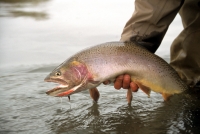
Like the South Fork the snowpack in the Teton River drainage was also close to 200% of normal. The flow was more than double the normal flow until almost the middle of July. While we lost over a month of fishing due to high water, once the river shaped up fishing was fantastic.
Like the Henry’s Fork, the Teton is divided into the upper river, the canyon section and the lower river. PMDs, caddisflies and a few golden stones provided great dry fly fishing in the slow upper section of the river. PMDs continued throughout the summer. Later on there were good hatches of Tricos and BWOs. There were always bugs coming off the upper river well into October.
The canyon section also produced great fishing, especially later in the summer with hoppers. As with past seasons, streamers also produced some very large fish. The lower water also provided great fishing after the runoff finally subsided in mid-July.
The Teton River is a relatively new offering for our guide clients as we didn’t have a legal permit to guide this river until 2014. For that reason our number of trips has increased each year as this option has become ever more popular. 2017 was no exception. We ran 44% more trips last year than in 2016.
Yellowstone Park
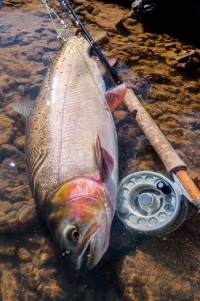
The big snowpack of 2017 was great for our favorite river in the park, the Firehole. The water stayed cool well into July providing exceptional dry fly fishing. Later, after the water warmed up our focus changed to other waters including the Yellowstone, Madison, Lamar, Slough Creek and the Beckler but we always run more trips on the Firehole than all of the other waters combined.
Our total for trips in Yellowstone Park was up 21% from 2016.
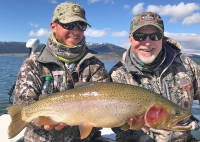
Of course there are a lot more fishing options in our area including Henry’s Lake, Hebgen Lake, Island Park Reservoir as well as a number of smaller streams. Our guiding efforts were mostly concentrated on Henry’s Lake and Hebgen Lake. Total trips on both lakes were up by about 20%.
It might seem weird that our guide trips were up everywhere but the South Fork. In 2016 we indeed ran a lot of trips on the South Fork but as noted we took less than half as many trips last season. Most of these moved to the Henry’s Fork and Madison. It’s always very interesting to me this time of year to reflect back to see where our guides concentrated their efforts.